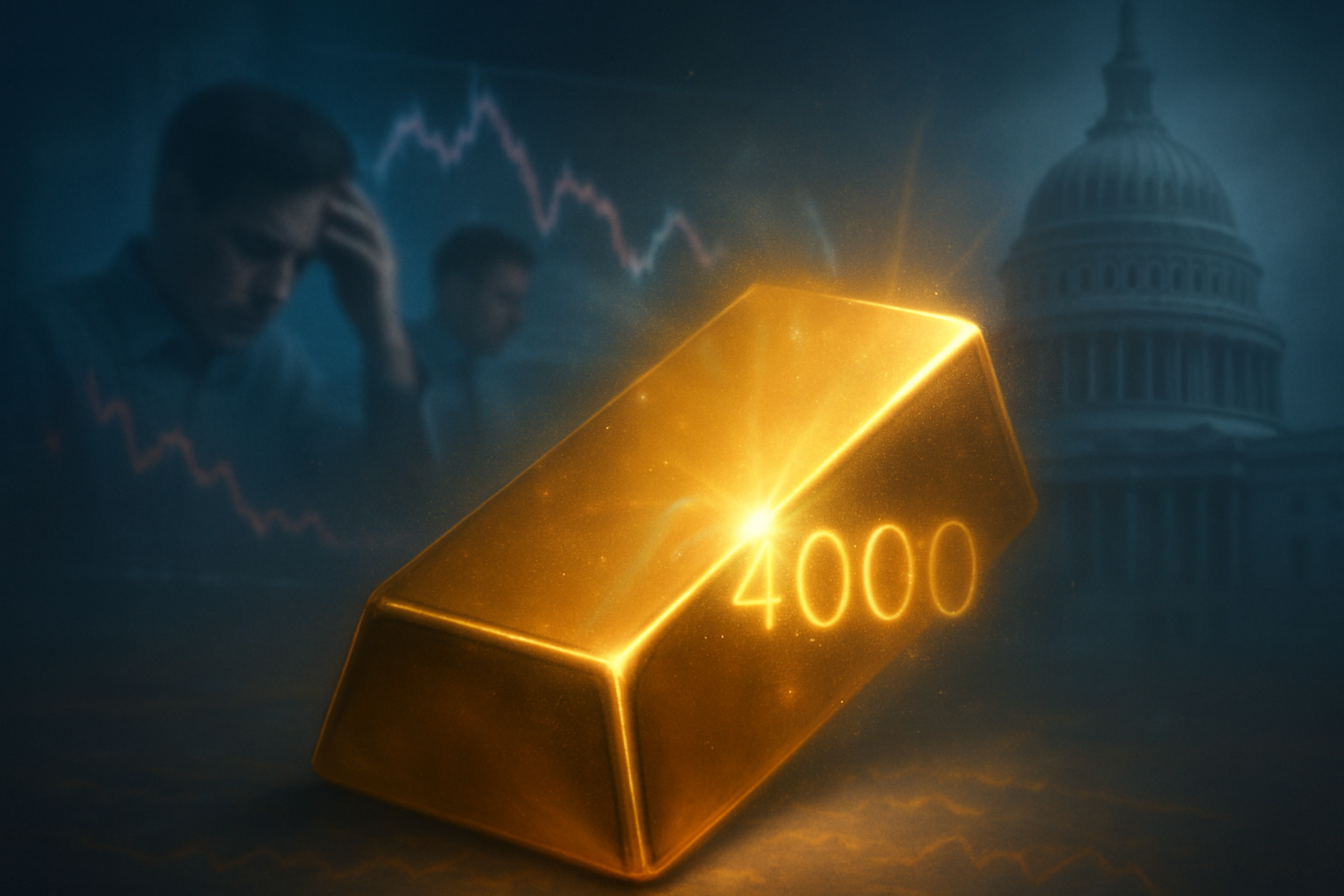
New York, NY – October 7, 2025 – In an unprecedented display of market apprehension, gold futures on the COMEX (New York Mercantile Exchange - NYMEX) have surged past the psychological and historical barrier of $4,000 per ounce for the first time ever. This monumental rally, which saw prices reach an all-time high of $3,990.83 before breaching $4,000 in early October, is directly attributed to an ongoing U.S. government shutdown, escalating global political uncertainties, and growing expectations of further Federal Reserve interest rate cuts. The breach of this critical threshold underscores a profound flight to safety as investors grapple with an increasingly volatile and unpredictable financial landscape.
The record-breaking ascent of gold, which has climbed nearly 50% year-to-date, reflects a market gripped by intense anxiety. As the U.S. government remains in a state of partial shutdown, a lack of fiscal resolution in Washington is fueling concerns about economic stability and governmental competence. This domestic political gridlock, combined with broader geopolitical tensions and the prospect of a weakening U.S. dollar, has solidified gold's role as the ultimate safe-haven asset, drawing capital away from riskier investments and into the precious metal.
Unpacking the Gold Rush: A Deep Dive into Market Dynamics
The historic breach of $4,000 per ounce for gold futures on the COMEX (NYMEX) in early October 2025 marks a pivotal moment in financial markets. The immediate catalyst for this surge is the protracted U.S. government shutdown, which began on October 1st after Congress failed to pass appropriation bills. This impasse has led to the furlough of hundreds of thousands of federal employees and the suspension of non-essential government services, injecting a fresh wave of uncertainty into an already fragile global economy.
Leading up to this moment, the market had been experiencing a steady build-up of bullish sentiment for gold. Throughout 2025, a confluence of factors – including persistent inflation concerns, robust central bank gold purchases (particularly from emerging markets), and a weakening U.S. dollar – had already propelled gold prices higher. The government shutdown acted as an accelerant, exacerbating investor fears and prompting a rapid re-evaluation of risk. Key players involved include the U.S. Congress and Administration, whose inability to reach a budget agreement directly triggered the shutdown, and the Federal Reserve, whose anticipated rate cuts reduce the opportunity cost of holding non-yielding gold. Initial market reactions have been characterized by a pronounced flight to safety, with significant capital inflows into gold-backed Exchange Traded Funds (ETFs) and a noticeable uptick in overall market volatility, as evidenced by a rising CBOE Volatility Index (VIX).
Corporate Fortunes: Winners and Losers in a Golden Era
The unprecedented surge in gold prices creates a distinct bifurcation in corporate fortunes, with some sectors poised for significant gains while others face mounting headwinds.
The Winners: Gold mining companies stand to be the most direct beneficiaries of this rally. Firms like Barrick Gold (NYSE: GOLD) and Newmont (NYSE: NEM) will see their revenue and profit margins expand significantly as the price of their primary commodity skyrockets. Higher gold prices directly translate to increased realized prices for their mined output, bolstering their financial performance and potentially leading to increased exploration and development activities. Similarly, companies involved in gold streaming and royalties, such as Franco-Nevada (TSX: FNV), will also see substantial boosts to their income streams. Furthermore, precious metals dealers, refiners, and manufacturers of gold-backed investment products are likely to experience heightened demand and increased transaction volumes. Gold-backed Exchange Traded Funds (ETFs) and other investment vehicles that track gold prices will also see their asset under management (AUM) grow, benefiting their sponsors.
The Losers: Conversely, the prolonged U.S. government shutdown and the underlying economic anxiety it represents will negatively impact a broad swathe of companies. Sectors heavily reliant on government contracts or regulatory approvals may face delays and disruptions, affecting their project timelines and revenue recognition. Companies in the retail and hospitality sectors could see reduced consumer spending due to furloughed federal workers and broader economic uncertainty. Financial institutions, while potentially benefiting from increased trading volumes in safe havens, will also grapple with heightened market volatility, credit risk concerns, and potential disruptions to lending and investment activities if the economic slowdown deepens. Furthermore, a weakening U.S. dollar, a common consequence of government shutdowns and fiscal instability, could negatively impact U.S. companies with significant import costs or those that repatriate earnings from stronger foreign currencies. Companies with high debt burdens may also face increased financing costs if market uncertainty leads to tighter credit conditions.
Broader Implications: A Shift in the Global Financial Paradigm
The breach of $4,000 per ounce for gold is not merely a market milestone; it signals a significant shift in broader industry trends and investor psychology, with far-reaching implications for global finance. This event fits into a growing narrative of de-dollarization and a global reassessment of reserve assets. Central banks, particularly in emerging markets, have been consistent buyers of gold, seeking to diversify their holdings away from fiat currencies and reduce exposure to U.S. sovereign risk. The current fiscal instability in the U.S. only reinforces this trend, suggesting a long-term structural demand for gold.
The ripple effects extend beyond precious metals. A sustained environment of high gold prices, driven by fear and uncertainty, could lead to increased interest in other alternative safe-haven assets, including potentially cryptocurrencies like Bitcoin (NASDAQ: MSTR), which some investors view as "digital gold." The instability could also trigger a re-evaluation of global supply chains and trade agreements, as nations seek to de-risk their economic dependencies. Regulatory and policy implications are significant, as repeated U.S. government shutdowns and ongoing fiscal brinkmanship will undoubtedly put immense pressure on U.S. lawmakers to implement more stable long-term budget solutions. Internationally, this situation could prompt global financial bodies to issue warnings about the stability of the U.S. economy and its impact on the global financial system. Historically, gold has consistently demonstrated its safe-haven properties during periods of severe economic and political stress, such as the 2008 financial crisis, where it significantly outperformed equities. The current scenario echoes these historical precedents, but with the added layer of a new psychological barrier broken, suggesting an even deeper level of systemic anxiety.
Navigating the Future: What Comes Next for Markets and Investors
The path forward for financial markets, particularly for gold, hinges critically on the resolution of the U.S. government shutdown and the broader economic and political landscape. In the short-term, if the shutdown persists, gold is likely to maintain its upward momentum, potentially consolidating around the $4,000 mark or even pushing higher as investor anxiety deepens. Continued delays in the release of critical economic data will further obscure the true state of the economy, fostering an environment of uncertainty that typically benefits gold.
Looking to the long-term, the sustainability of gold's elevated prices will depend on whether the underlying drivers – fiscal instability, inflation concerns, and geopolitical tensions – become entrenched. A quick resolution to the shutdown, coupled with a clear path for U.S. fiscal policy, could lead to a modest correction in gold prices as some risk appetite returns. However, if the pattern of political gridlock and fiscal uncertainty becomes a recurring feature, gold could establish a new, permanently higher trading range, reflecting a fundamental shift in investor confidence. This scenario presents both market opportunities and challenges. Opportunities lie in gold-related investments, potentially extending to other precious metals or commodities that benefit from inflation hedging. Challenges include increased volatility across equity markets, potential for bond market instability, and a need for investors to adapt to a more defensive asset allocation strategy. Potential scenarios range from a swift, market-reassuring resolution that sees gold ease back, to a prolonged crisis that could propel gold towards even higher, previously unimaginable, levels, with some analysts already forecasting $4,900 an ounce by December 2026.
A Golden Signal: Summarizing the New Era of Uncertainty
The unprecedented surge of gold futures past $4,000 per ounce, catalyzed by a U.S. government shutdown, serves as a stark and undeniable signal of profound investor anxiety and a shifting global financial paradigm. This event underscores gold's enduring role as the quintessential safe-haven asset, a store of value that gains prominence when confidence in traditional financial systems and governmental stability wanes. The market's reaction highlights a growing discomfort with political gridlock, persistent inflationary pressures, and a search for tangible assets in an increasingly digital and uncertain world.
Moving forward, the financial markets will remain highly sensitive to macro-economic and political developments. The $4,000 mark is more than just a price point; it's a psychological barrier that, once breached, suggests a new era of heightened financial uncertainty and a potentially long-term re-evaluation of risk. Investors should watch closely for any signs of a resolution to the U.S. government shutdown, which could provide temporary relief but may not address deeper structural issues. Furthermore, the Federal Reserve's monetary policy decisions, particularly regarding interest rates, and ongoing global geopolitical developments will continue to exert significant influence on gold's trajectory. This golden ascent is a powerful indicator that investors are increasingly prioritizing capital preservation and diversification in the face of escalating systemic risks.
This content is intended for informational purposes only and is not financial advice






